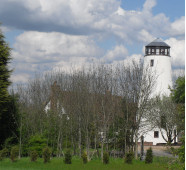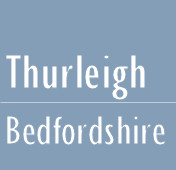|
The following route was a from a set of three walks
reproduced in a leaflet in 2000, A colour map of these walks
can be found on the wall of the Village Hall,
a black and white copy is available
here
Dogs
MUST be kept on a lead at
Stages 1 - 3 and Stage 6.
1. Start
from the Village Hall and proceed down the signposted
footpath behind the School.
(Thurleigh was the first village in North Bedfordshire to
have its own Village Hall (1927). The original wooden
building was erected on the site of the old church school,
it was refurbished in the 1970s and later rebuilt as you see
it today. The School was built in 1876 and little
effort was made to blend in with the Victorian building when
four classrooms were added in 1973. Walking down the hill in
the distance on the right can be seen Thurleigh
Manor, formerly called Whitwick Manor, which was built
in 1833 within the moated site of Thurleigh Hall, previously
destroyed by fire).
2. Turn
right at the waymarker at the bottom of the hill, keep to
the right hand side of the brook along the field edge, past
the Sewage Works and continue to the Reservoirs. (The two
Reservoirs were installed to take excess water from the
airfield runways. By the kind permission of their new
owners, St. Modwen Developments Ltd., local people are
working to turn the reservoirs into a conservation area.
The tranquil site is already rich in wildflowers, insects
and waterfowl).



3. Walk
ahead along the permissive path on the left hand side of the
reservoirs and then turn right before the airfield fence
onto the bridleway. Keep on the bridleway which becomes a
hardcore track leading to Keysoe Road.
4. Cross
the road onto the signposted footpath directly ahead.
This waymarked path is partly ditched, partly rough meadow
(the site of a former airfield radio installation which
hosts a whole variety of interesting wildflowers) and
partly across open land.
5. At the
newly built footbridge, turn right onto Cross End Lane
and continue down the lane to the stile and signposted
footpath in the hedgerow on the right . (Cross End
Lane now a Byway Open to All Traffic (BOAT), is shown on
a 1765 County map as the main highway between Thurleigh and
Keysoe)
6. Climb
the stile, then over two more stiles (Beware of Horses),
and walk ahead to the waymarker post on the opposite side of
the field.
7.
Continue along the hedge to the waymarked gap, bear left and
walk down the inside of the Playing Field to Keysoe Road.
8. Turn
left on the road, then right through the Close. (Clearly
visible ahead when walking down Keysoe Road is the rear of
the Chapel. The initial Baptist church was erected in
1827 on land adjacent to a pair of cottages bequested to
the church as a manse by its first minister. The original
church was extremely small and was twice enlarged to
accommodate its increasing congregation. In 1888 the present
red-brick Chapel was erected. Immediately opposite the
Chapel is the Village Garden).
9.Turn
right into the High Street and return to the Village Hall. (On
the corner of Vicarage Green is the Old Vicarage.
Evidence that the village was inhabited from very early ages
was uncovered when an archaeological "dig" took place in the
grounds during 1976. It unearthed an Iron Age hearth,
several Roman remains and also the outer bank and ditch of
Thurleigh castle).
The
leaflet this walk was taken from was prepared by Thurleigh
Parish Council and Village Members of the Parish Paths
Partnership in conjunction with much appreciated assistance
from the Environmental Service Officers at Bedfordshire
County Council and The British Trust for Conservation
Volunteers (B.T.C.V.). Most of the information about the
village has been taken, with the kind permission of Mrs Judy
Stanton and Mrs Lilian Wildman, from their booklet "Thurleigh
Through The Years" published in 1998.
See all public
footpaths, bridleways and byway open to all traffic (BOAT)
on the
Bedford Borough Council Website |





